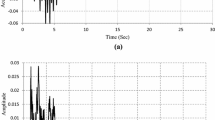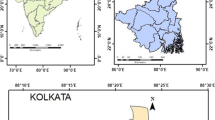Abstract
Mumbai city is the economical capital of India and is situated about midway on the western coast of stable continental region of Peninsular India. Major part of the city being of reclaimed land, the soil type is of alluvium, sand, and recent conglomerate. There are some bigger water bodies within the city range. In this study, an attempt has been made to study the susceptibility of soil liquefaction using simplified empirical procedure based on number of blow counts (N values) of the soil layers from standard penetration test. The liquefaction susceptibility is quantified in terms of factor of safety along the borehole depths at available borehole locations using earthquake-induced cyclic stress on the soil and the cyclic resistance of the soil to withstand the load. The factor of safety against liquefaction is evaluated at different sites for two peak ground acceleration (PGA) levels pertaining to 10 and 2 % probability of exceedance in 50 years corresponding to uniform hazard response spectra for Mumbai city with 475- and 2,475-year return period, respectively. Contour maps are prepared that display the factor of safety at different depths for earthquake magnitude of M w 6.5. These contour maps show the liquefaction vulnerability at different sites in the city.







Similar content being viewed by others
References
BSSC (2009) NEHRP recommended provisions for seismic regulations for new buildings and other structures. Building Seismic Safety Council, Federal Emergency Management Agency, Washington DC
Boulanger RW (2003) Relating K α to relative state parameter index. J Geotech Geoenviron Eng ASCE 129(8):770–773
Boulanger RW, Idriss IM (2004) State normalization of penetration resistance and the effect of overburden stress on liquefaction resistance. In: Proceedings of 11th international conference on soil dynamics and earthquake engineering and 3rd international conference on earthquake geotechnical engineering. University of California, Berkeley, CA, pp 484–491
Cetin KO et al (2004) Standard penetration test-based probabilistic and deterministic assessment of seismic soil liquefaction potential. J Geotech Eng ASCE 130(12):1314–1340
Chandra U (1977) Earthquakes of peninsular India—a seismotectonic study. Bull Seismol Soc Am 65:1387–1413
IBC (2003) International Building Code. International Code Council, Country Club Hills, Illinois
Idriss IM (1999) An update to the Seed-Idriss simplified procedure for evaluating liquefaction potential. In: Proceedings, TRB workshop on new approaches to liquefaction, publication no. FHWARD-99-165, Federal Highway Administration
Idriss IM, Boulanger RW (2006) Semi-empirical procedures for evaluating liquefaction potential during earthquakes. Soil Dyn Earthq Eng 26:115–130
Idriss IM, Boulanger RW (2010) SPT-based liquefaction triggering procedures. Report no. UCD/CGM-10/02, Center for Geotechnical Modeling, University of California, Davis
Imai T (1977) P- and S-wave velocities for the ground in Japan. In: Proceedings of 9th international conference on soil mechanics and foundation engineering, Tokyo, pp 257–260
Imai T, Tonouchi K (1982) Correlation of N-value with S-wave velocity and shear modulus. In: Proceedings of the 2nd European symposium of penetration testing, Amsterdam, A.A. Balkema Publishers, The Netherlands, pp 57–72
IS 1893: part 1 (2002) Criteria for earthquake resistant design of structure. Bureau of Indian Standards, New Delhi
Juang CH, Chen CJ, Rosowsky DV, Tang WH (2000a) CPT-based liquefaction analysis part 1: determination of limit state function. Geotechnique 50(5):583–592
Juang CH, Chen CJ, Rosowsky DV, Tang WH (2000b) CPT-based liquefaction analysis part 2: reliability for design. Geotechnique 50(5):593–599
Kramer SL (1996) Geotechnical earthquake engineering. Prentice Hall, New Jersey
Liao SSC, Veneziano D, Whitman RV (1988) Regression models for evaluating liquefaction probability. J Geotech Eng ASCE 114(4):389–411
Martin S, Szeliga W (2010) A catalog of felt intensity data for 570 earthquakes in India from 1636 to 2009. Bull Seismol Soc Am 100(2):562–569
Mhaske SY, Choudhury D (2010) GIS-based soil liquefaction susceptibility map of Mumbai city for earthquake events. J Appl Geophys 70:216–225
Moss RES, Seed RB, Kayen RE, Stewart JP, der Kiureghian A, Cetin KO (2006) CPT-based probabilistic and deterministic assessment of in situ seismic soil liquefaction potential. J Geotech Geoenviron Eng ASCE 132(8):1032–1051
Ohta Y, Goto N (1978) Empirical shear wave velocity equation in terms of characteristic soil indexes. Earthquake Eng Struct Dynam 6:167–187
Raghukanth STG (2011) Seismicity parameters for important urban agglomerations in India. Bull Earthq Eng 9(5):1361–1386
Raghukanth STG, Iyengar RN (2006) Seismic hazard estimation for Mumbai city. Curr Sci 91(11):1486–1494
Seed HB, Idriss IM (1971) Simplified procedure for evaluating soil liquefaction potential. J Soil Mech Found Div ASCE 97(9):1249–1273
Seed HB, Tokimatsu K, Harder LF, Chung R (1985) Influence of SPT procedures in soil liquefaction resistance evaluations. J Geotech Eng Div ASCE 111(12):1425–1445
Youd TL, Idriss IM (eds) (1997) Proceedings of the NCEER workshop on evaluation of liquefaction resistance of soils. Technical report NCEER-97-0022, Multidisciplinary Center for Earthquake Engineering Research, Buffalo, New York
Youd TL, Noble SK (1997) Liquefaction criteria based on statistical and probabilistic analyses. In: Proceedings of NCEER workshop, technical report NCEER-97-0022, pp 201-216
Youd TL, Perkins DM (1978) Mapping liquefaction-induced ground failure potential. J Geotech Eng Div ASCE 104(4):443–446
Youd et al (2001) Liquefaction resistance of soils summary report from 1996 NCEER and 1998 NCEER/NSF workshops on evaluation of liquefaction resistance of soil. J Geotech Geoenviron Eng ASCE 127(10):817–833
Acknowledgments
The authors extend their thanks to M/S DBM Geotechnics and Constructions Pvt Ltd., Mumbai, for providing the borehole data at different sites in the study area, and the authors also gratefully acknowledge the help of S. V. Suryawanshi, IIT Bombay.
Author information
Authors and Affiliations
Corresponding author
Rights and permissions
About this article
Cite this article
Dixit, J., Dewaikar, D.M. & Jangid, R.S. Soil liquefaction studies at Mumbai city. Nat Hazards 63, 375–390 (2012). https://doi.org/10.1007/s11069-012-0154-0
Received:
Accepted:
Published:
Issue Date:
DOI: https://doi.org/10.1007/s11069-012-0154-0




